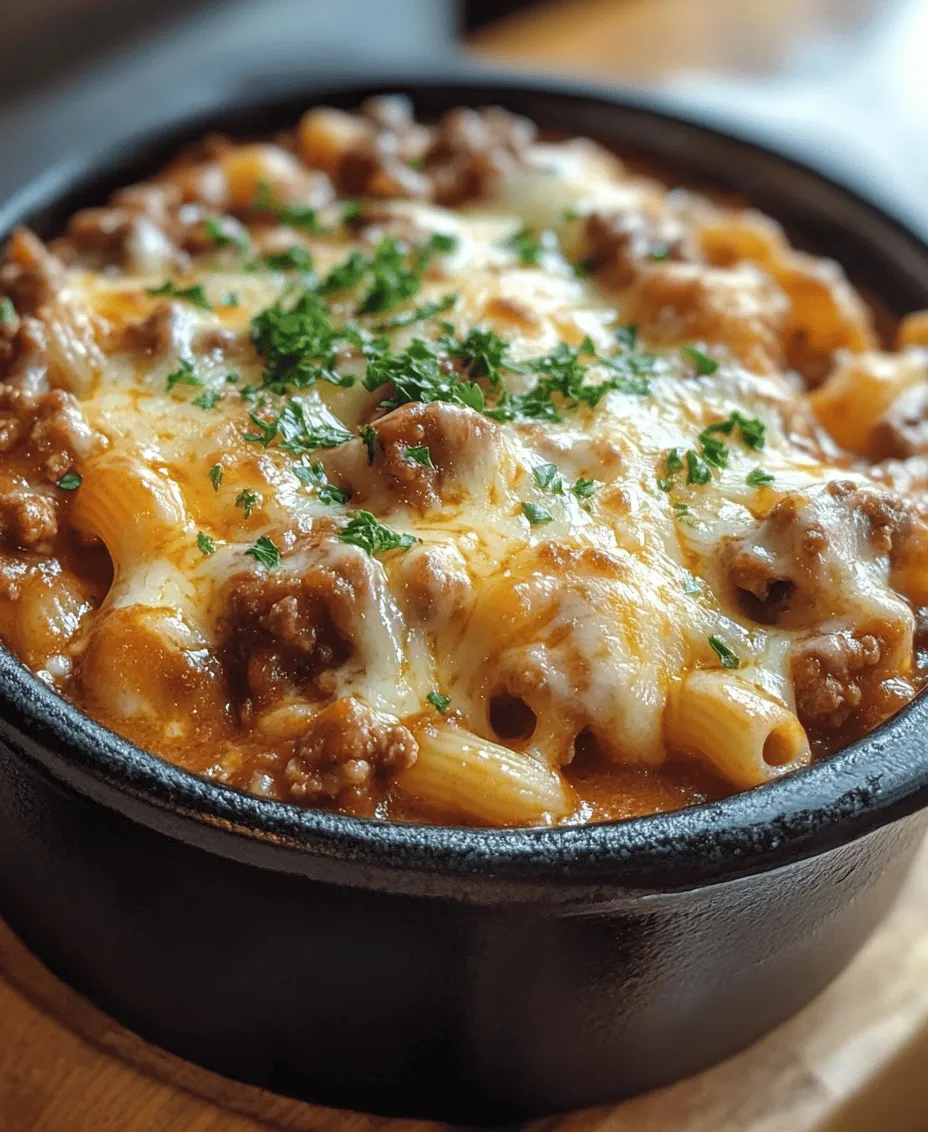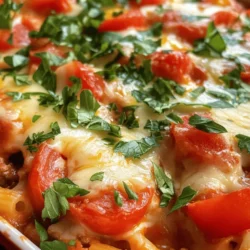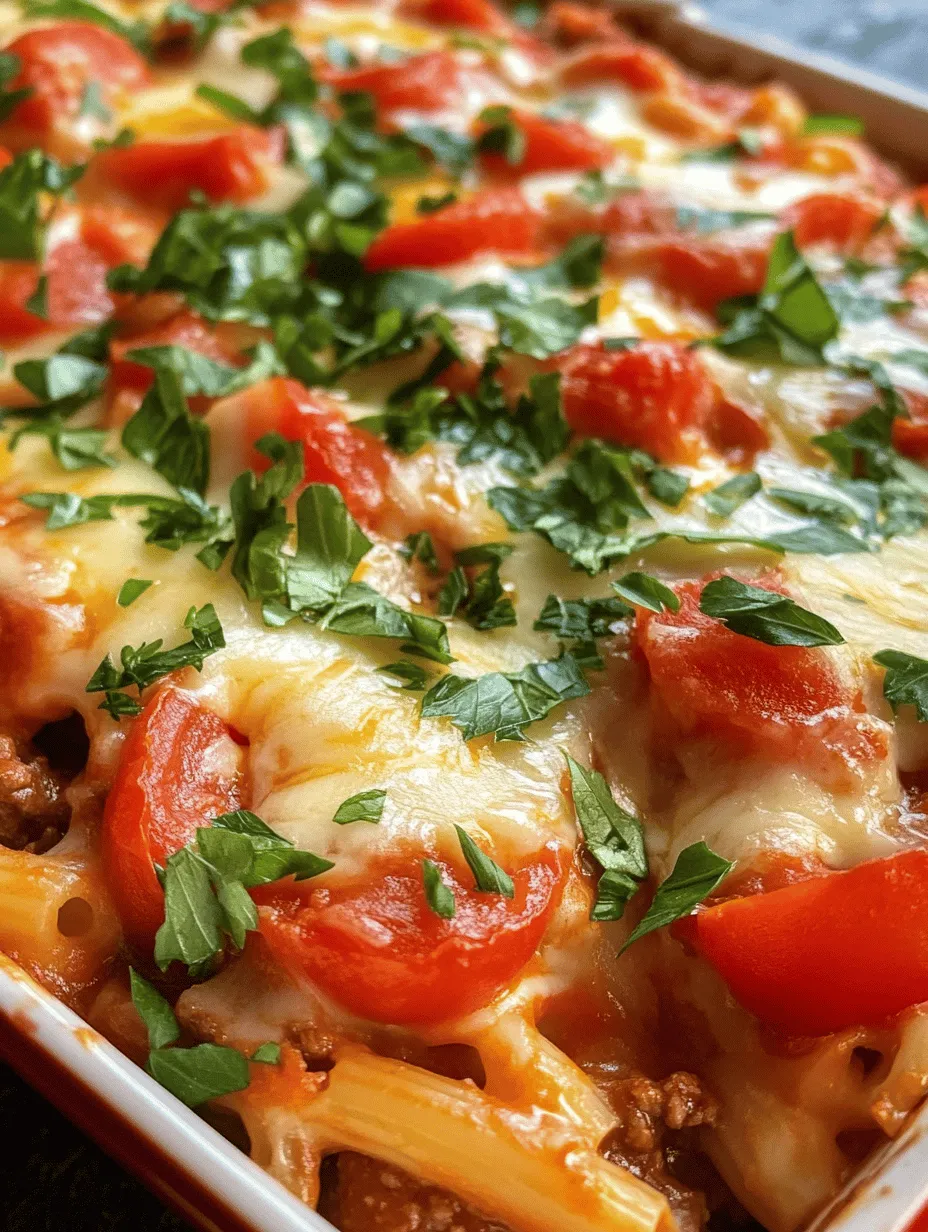Introduction
Beefaroni is more than just a dish; it’s a comforting reminder of childhood, family dinners, and the simple joys of home-cooked meals. This hearty combination of pasta and beef in a rich tomato sauce has found its way into the hearts—and stomachs—of many, often becoming a staple in family kitchens across the country. The appeal of Beefaroni lies not only in its nostalgic flavor but also in its versatility and ease of preparation. While many people might have grown up enjoying the convenience of a canned version, making Beefaroni at home elevates it to a whole new level, allowing you to tailor it to your family’s tastes and dietary needs.
Creating Beefaroni from scratch means you have complete control over the ingredients. You can choose high-quality meats, select organic pasta, or incorporate fresh vegetables, making it not only a satisfying meal but also a healthier alternative. Cooking together as a family can also transform this dish into a cherished bonding experience, where everyone can contribute to the preparation and enjoy the fruits of their labor.
In this article, we will guide you through the process of crafting your ultimate homemade Beefaroni experience, exploring its history, essential ingredients, and the steps involved in creating this beloved dish.
Understanding Beefaroni: The History and Appeal
The origins of Beefaroni can be traced back to the mid-20th century, when convenience foods began to rise in popularity. The dish is often associated with comfort food, reminiscent of quick meals that busy families could prepare without much fuss. Although the exact roots of Beefaroni are somewhat murky, its popularity surged in the 1960s, becoming a staple in many American households. The combination of pasta, beef, and a tangy tomato sauce made it an instant hit with children and adults alike.
What makes Beefaroni particularly appealing is its adaptability. Over the years, families have put their own spins on the dish, incorporating various ingredients and flavors. Whether it’s a spicy kick from red pepper flakes, extra veggies for a nutritional boost, or a sprinkle of herbs for added fragrance, Beefaroni can easily cater to individual tastes. This versatility ensures that even as generations pass, the dish remains relevant and beloved.
The dish resonates with people on multiple levels, from those who recall it as a comforting childhood meal to others who appreciate its hearty nature as a quick weeknight dinner. It is a dish that transcends age, bringing families together around the dinner table, where stories are shared, and memories are made.
Ingredients Breakdown: The Key Components of Beefaroni
Ground Beef: Choosing the Right Type
The foundation of any great Beefaroni is the ground beef. Selecting the right type of ground beef is crucial, as it affects both the flavor and texture of the dish. Here are some options to consider:
– Regular Ground Beef: This is typically 70-80% lean and 20-30% fat. The fat adds flavor and juiciness, making it a popular choice for many home cooks.
– Lean Ground Beef: Often around 90% lean, this option is healthier, with less fat. However, it may require a little extra seasoning to enhance the flavor since it lacks some of the richness that comes from higher-fat content.
– Extra Lean Ground Beef: This is usually 95% lean or higher. While it’s a healthier alternative, it can result in a drier dish if not cooked properly. Adding a splash of beef broth or olive oil during cooking can help maintain moisture.
– Grass-Fed Ground Beef: This type is not only rich in flavor but also comes with added health benefits, such as higher omega-3 fatty acids. It can be a bit pricier but is worth considering for its superior taste and nutritional profile.
When selecting ground beef, look for meat that is bright red with minimal graying. Freshness is key, and purchasing from a trusted butcher can ensure quality.
Pasta Selection: Elbow Macaroni and Beyond
Traditionally, elbow macaroni is the pasta shape of choice for Beefaroni. Its small, tubular shape is perfect for holding onto the sauce, making each bite rich and flavorful. However, if you’re feeling adventurous, there are several alternatives you might consider:
– Shell Pasta: The curves of shell pasta are excellent for trapping sauce inside, offering a delightful burst of flavor in every bite.
– Penne or Ziti: These shapes provide a bit more texture, with their ridges helping to cling to the sauce. They also make for a heartier dish.
– Rotini: The spirals of rotini can create a fun twist on the classic dish, capturing chunks of ground beef and sauce in their coils.
– Gluten-Free Options: If you or a family member has dietary restrictions, there are a variety of gluten-free pasta options available today made from rice, quinoa, or lentils that can work well in Beefaroni.
When cooking pasta for Beefaroni, ensure it is al dente, as it will continue to cook slightly when mixed with the sauce later on.
Sauces and Seasonings: Building Flavor Layers
The sauce is where the magic happens in Beefaroni. A well-crafted sauce brings the dish together, and using high-quality ingredients can significantly enhance the overall flavor. Here are the key components:
– Tomato Sauce: A good quality tomato sauce serves as the base for your Beefaroni. Look for options that are low in added sugar and preservatives. You can also make your own sauce using crushed tomatoes, garlic, and herbs for a fresher taste.
– Diced Tomatoes: Adding diced tomatoes provides texture and a burst of flavor. Opt for fire-roasted diced tomatoes for a smoky undertone.
– Worcestershire Sauce: This ingredient adds depth and umami to the dish, balancing the sweetness of the tomatoes. A splash of Worcestershire sauce can elevate your Beefaroni to new heights.
– Italian Seasoning: A blend of dried herbs such as basil, oregano, and thyme enhances the dish’s flavor profile. Tailor the amount to suit your taste, adding more for a bolder flavor.
– Sugar: While it may seem counterintuitive, adding a small amount of sugar can help balance the acidity of the tomatoes, resulting in a more harmonious sauce.
– Salt and Pepper: These staples should not be overlooked, as they bring out the flavors of all the other ingredients. Season to taste throughout the cooking process for the best results.
Cheesy Goodness: The Role of Cheddar Cheese
One of the most delightful aspects of Beefaroni is the cheesy component that ties everything together. Cheddar cheese is the classic choice, offering a sharp and creamy texture that complements the richness of the beef and sauce. However, cheese lovers may want to experiment with other varieties, such as:
– Mozzarella: For a creamier texture and excellent meltability, mozzarella cheese is a fantastic addition. It can be layered on top before baking for a gooey finish.
– Parmesan: A sprinkle of grated Parmesan adds a nutty flavor and a savory finish to your Beefaroni.
– Monterey Jack: This cheese melts beautifully, providing a mild flavor that can work well with additional spices.
– Vegan Cheese: For those following a plant-based diet, there are several excellent vegan cheese options available that melt well and provide a satisfying flavor.
Using cheese in moderation can enhance the dish without overwhelming it. Ultimately, the choice of cheese can reflect personal preferences and dietary needs, making it a customizable aspect of your homemade Beefaroni.
Preparation Steps: Crafting the Perfect Beefaroni
Cooking the Macaroni: Tips for Perfect Pasta
Cooking the macaroni properly is crucial to achieving the perfect Beefaroni. Here are some tips to ensure your pasta turns out just right:
1. Use a Large Pot: When boiling pasta, always use a large pot filled with plenty of water. This helps prevent the pasta from sticking together and ensures even cooking.
2. Salt the Water: Once the water reaches a rolling boil, add a generous amount of salt. This is your opportunity to infuse flavor into the pasta itself.
3. Cook to Al Dente: Follow the cooking instructions on the pasta package, but aim to cook the macaroni until it is al dente. This means it should be firm to the bite, as it will continue to cook when mixed with the sauce.
4. Drain and Rinse: Once the pasta is cooked, drain it in a colander. Rinsing the macaroni briefly with cold water can help stop the cooking process and prevent overcooking. However, if you prefer a creamier sauce, you might want to skip rinsing to retain the starch on the pasta.
5. Toss with a Little Oil: To prevent the macaroni from sticking together while you prepare the sauce, toss it with a splash of olive oil after draining.
Following these steps will set the groundwork for a delicious Beefaroni that your family will love. In the next section, we will dive deeper into crafting the sauce and combining all the ingredients for the ultimate homemade Beefaroni experience.

Cooking Elbow Macaroni to Perfection
To achieve the perfect al dente texture for your elbow macaroni, start by bringing a large pot of salted water to a rolling boil. The salt is crucial, as it enhances the pasta’s flavor. Once the water is boiling, add the elbow macaroni and stir immediately to prevent the pasta from sticking together.
Cook the macaroni according to the package instructions, usually around 7-8 minutes, but keep a close watch. For an authentic Beefaroni experience, you’ll want the pasta to be al dente, meaning it should still have a slight bite to it when tasted. To check for doneness, taste a piece of macaroni a minute or two before the package time is up. Once it reaches the perfect texture, drain the macaroni in a colander and rinse it briefly under cold water to stop the cooking process. Toss it with a bit of olive oil to prevent it from sticking while you prepare the sauce and beef mixture.
Browning the Beef: Techniques for Flavor
Browning the beef is a vital step in building the flavor base for your Beefaroni. Start by selecting high-quality ground beef, preferably 80/20 for the right balance of flavor and moisture. In a large skillet over medium-high heat, add a tablespoon of olive oil, and once hot, add the ground beef.
As the beef cooks, break it apart with a spatula to ensure even browning. The goal here is to develop a rich, brown crust on the meat. This caramelization creates depth of flavor that will elevate your dish.
After the beef has browned, add finely chopped onions and minced garlic to the pan. Cook these aromatics with the beef until they become translucent, about 3-4 minutes. This step is crucial as it infuses the beef with a savory aroma and enhances the overall flavor profile of the dish.
Be mindful not to overcook the beef. It should be browned but not burnt, as burnt bits can impart a bitter taste to your sauce. Drain any excess fat if necessary, but leave some in the pan to help flavor the sauce.
Creating the Sauce: The Simmering Process
With the beef and aromatics ready, it’s time to create the sauce. In the same skillet, add crushed tomatoes, tomato sauce, and a splash of beef broth or water to create a harmonious blend. Stir in Italian seasoning, a pinch of red pepper flakes for heat, and a teaspoon of sugar to balance the acidity of the tomatoes.
Let the mixture come to a gentle simmer, then reduce the heat to low. Allow it to simmer uncovered for at least 15-20 minutes, stirring occasionally. This simmering process is essential as it allows the flavors to meld together beautifully. The longer you let it simmer, the more delicious and concentrated the flavors will become.
Don’t forget to taste and adjust the seasoning before combining it with the macaroni. A little salt and pepper can make a world of difference, enhancing the overall taste of your Beefaroni.
Combining Ingredients: Mixing Pasta and Sauce
Once your sauce is ready and the macaroni has been cooked and drained, it’s time to combine the two. In the skillet with the sauce, add the cooked elbow macaroni and mix well until all the pasta is coated with the rich tomato sauce. This step is critical for flavor absorption; as the macaroni sits in the sauce, it will soak up all those delicious flavors.
If the mixture seems too thick, you can add a splash of reserved pasta water to loosen it up. This technique not only helps in achieving the desired consistency but also adds a bit of starch, which helps the sauce cling to the pasta.
Stir gently to ensure all macaroni is evenly distributed throughout the sauce without breaking the pasta. This careful mixing will contribute to a delightful texture in every bite of your Beefaroni.
Finishing Touches: Melting the Cheese
No Beefaroni is complete without its cheesy topping. After mixing the pasta and sauce, sprinkle a generous amount of shredded cheese on top. Mozzarella is a classic choice for its melty texture, but feel free to mix in some cheddar for an extra flavor boost.
Cover the skillet with a lid and let it cook on low heat for about 5 minutes, or until the cheese has melted beautifully. You could also place the skillet under the broiler for 2-3 minutes for a crispy, golden finish.
After the cheese has melted, remove the skillet from the heat and let it sit for a few minutes before serving. This resting time allows the flavors to settle and the dish to firm up slightly, making it easier to serve.
Serving Suggestions: Elevating Your Meal
When it comes to serving Beefaroni, presentation plays a vital role in enhancing the dining experience.
Presentation Ideas: Making it Visually Appealing
Serve your Beefaroni in rustic bowls for a homely touch. A sprinkle of freshly chopped parsley on top not only adds a pop of color but also introduces a fresh flavor that complements the richness of the dish.
For a comforting presentation, consider serving it alongside warm garlic bread or a side salad to add freshness and crunch. If you want to elevate your dish further, drizzle a bit of balsamic glaze over the top or add a sprinkle of grated Parmesan cheese for an added layer of flavor.
Pairing Options: What Goes Well with Beefaroni
To enhance your Beefaroni experience, consider pairing it with a simple side salad featuring mixed greens, cherry tomatoes, and a light vinaigrette. This contrast of textures and flavors helps to balance the richness of the pasta dish.
As for beverages, a light-bodied red wine, such as Chianti or a fruity Italian Sangiovese, pairs beautifully with the beef and tomato flavors. For a non-alcoholic option, try sparkling water with a slice of lemon or a refreshing iced tea to cleanse the palate.
Conclusion
Creating your own homemade Beefaroni is not just a way to satisfy hunger; it’s a delightful cooking experience that brings families together around the table. This dish, with its rich flavors and comforting texture, is a nostalgic favorite that can be enjoyed by all ages.
By following the steps outlined above, you’ll not only create a meal that’s delicious but one that carries the warmth and love of home cooking. Encourage your family to join you in the kitchen, sharing the joy of preparing this comforting classic. So roll up your sleeves, gather your ingredients, and embrace the ultimate homemade Beefaroni experience!


